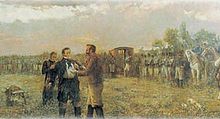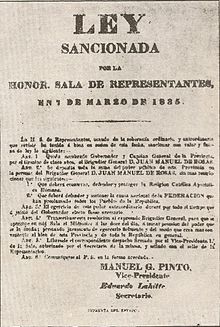Rise of the Argentine Republic
The viceroyalty sought to complement the existing trade routes with new ones, entering South America through the Río de la Plata.The American and French Revolutions gave room to the Age of Enlightenment, a new era of ideas that rejected the absolute monarchies and favored liberalism instead.The viceroy, Rafael de Sobremonte, fled to Córdoba during the conflict, but could not return to Buenos Aires after the liberation: an open cabildo gave Santiago de Liniers (who led the Spanish forces in the conflict) the military authority over the city, while it prepared for a British counter-attack, and ordered Sobremonte to stay out.The 1808 Peninsular War was triggered by an event of huge political weight: the king of Spain, Ferdinand VII, was captured and imprisoned by the French armies of Napoleon.His project was to replace Liniers with a Junta, ruling nominally in the name of Ferdinand VII, and declare independence once Spain was completely invaded by the French forces.A small secret society of criollos, composed of politicians such as Manuel Belgrano and Juan José Castelli, and military officers such as Antonio Beruti and Hipólito Vieytes, supported this project.The project was resisted by viceroy Liniers, most peninsulars, and some criollos, including Mariano Moreno, Juan José Paso, and Cornelio Saavedra.The supporters of Carlota Joaquina intended her to head a constitutional monarchy, whereas she wanted to govern as an absolute monarch; these conflicting goals undermined the project and caused it to fail.Britain, which had a strong influence in the politics of the Portuguese Empire, opposed the project as well: the British wanted to prevent Spain from splitting into many kingdoms, and considered Carlota Joaquina unable to prevent this.The disputes between Álzaga and Liniers were noticed by the Central Junta, which appointed a new viceroy instead of Liniers: Baltasar Hidalgo de Cisneros.He then proposed to prevent rushed actions, and suggested to establish a government body with the governors of other Spanish territories, such as Abascal or Nieto.The Primera Junta was initially resisted by the Cabildo and the Royal Audiencia, still loyal to the absolutist factions, and by other provinces who did not accept its authority.The Junta got divided between factions supporting the president Cornelio Saavedra and the secretary Mariano Moreno, who favored moderated and radical reforms respectively.The Cabildo created a new executive power, the First Triumvirate, composed of three members: Manuel de Sarratea, Feliciano Chiclana and Juan José Paso.Artigas organized the Federal League in response, with the Banda Oriental, the Argentine Mesopotamia, Santa Fe and Córdoba united against Buenos Aires under federalist principles.Once in government, the second triumvirate called for the Assembly of Year XIII, a constituent body with deputies from the other provinces that would write a national constitution.Facing an adverse context in the war of independence, Alvear considered turning the United Provinces into a British protectorate, which motivated a coup against him.An open cabildo in Buenos Aires elected a new governor, Manuel de Sarratea, who negotiated the Treaty of Pilar with Ramírez and López.Ramírez proclaimed the independence of the Republic of Entre Ríos, with the intention to annex Paraguay and Buenos Aires and liberate the Banda Oriental with their combined forces, but this short-lived project ended after his assassination.It was thought then in Buenos Aires that to wage the war the country should have a proper head of state, so a new congress began to write a constitution for this, which would be enacted in 1826.In the lack of a proper head of state, the governor of Buenos Aires received some powers to fill that void, such as managing international relations or paying the foreign debt.Lavalle captured and executed Dorrego, appointed himself governor of Buenos Aires, closed the legislature and began a campaign against federalists, together with José María Paz.Lavalle was not recognized as a legitimate governor by the other provinces, and sought the support of José de San Martín, who had returned from Europe, to aid him in the war against Brazil.The hacendado Juan Manuel de Rosas organized a militia with people from the countryside to stand against Lavalle, while Estanislao López dealt with Paz.The provinces of Buenos Aires, Santa Fe and Entre Ríos signed the Federal Pact in response, and quickly defeated the Unitarian League by capturing Paz.The Federal Pact had an article declaring that a new constituent assembly should be called to write a constitution as soon as the military threats were defeated.The context changed with the social commotion generated by the death of Facundo Quiroga, responsibility for which is disputed (different authors attribute it to Estanislao López, the Reinafé brothers, or even Rosas himself).There are divided opinions on the topic: Domingo Faustino Sarmiento compared Rosas with historical dictators, while José de San Martín considered that the situation in the country was so chaotic that a strong authority was needed to create order.Rosas' opponents during his rule were dissidents, such as José María Paz, Salvador M. del Carril, Juan Bautista Alberdi, Esteban Echeverria, Bartolomé Mitre and Domingo Faustino Sarmiento.Justo José de Urquiza, governor of Entre Ríos, thought by then that it was the time required by the Federal Pact to establish a Constitution, but Rosas still kept his idea of doing it after all provinces had already organized themselves.





Argentine War of IndependenceArgentine Civil WarsHistory of ArgentinaPre-ColumbianIndigenous peoples in ArgentinaInca EmpireColonial ArgentinaGovernorate of New AndalusiaGovernorate of the Río de la PlataRoyal Audiencia of Buenos AiresViceroyalty of the Río de la PlataIndependenceMay RevolutionWar of IndependenceUnited Provinces of the Río de la PlataCongress of TucumánCivil WarsBernardino RivadaviaConfederationJuan Manuel de RosasFrench blockade of the Río de la PlataAnglo-French blockade of the Río de la Plata1853 ConstitutionBritish investment in ArgentinaConquest of the DesertGeneration of '80Radical Phase (1916–30)The Infamous DecadePeronismJuan PerónEva PerónGeneral Confederation of LabourRevolución LibertadoraArturo Frondizi1963 Argentine Navy revoltArturo Umberto IlliaArgentine RevolutionMontonerosNational Reorganization ProcessDirty WarFalklands War(Guerra de las Malvinas)Return to democracyTrial of the JuntasRaúl AlfonsínDecember 2001 riotsKirchnerismCorruptionEconomyEtymologyJewish ArgentinesMilitaryNationalityPostalRail transportScience and technologyTimelineYears in ArgentinacolonySpanish EmpireKing of SpainviceroyrepublicanEmpire of BrazilFirst Mexican EmpireBuenos Airescentralised governmentfederationUnitariansFederalistsArgentine ConfederationBoliviaParaguayRepublic of Entre RíosArgentine Constitution of 1853Causes of the May RevolutionViceroyalty of PeruRío de la Plata Basinprecious metalsNew SpainRío de la PlataNapoleonic Warsbattle of TrafalgarAmericanFrench RevolutionsAge of Enlightenmentabsolute monarchiesliberalismcriollosUniversity of Chuquisacaconstitutional monarchyBritish invasions of the Río de la PlataRafael de Sobremonteopen cabildoSantiago de LiniersPeninsular WarFerdinand VIISupreme Central and Governing Junta of the KingdomFrancisco Javier de ElíoBanda OrientalMartín de ÁlzagamutinyCarlota Joaquinaprince regent Johnfleeing the Napoleonic invasion of PortugalManuel BelgranoJuan José CastelliAntonio BerutiHipólito VieytesMariano MorenoJuan José PasoCornelio SaavedraPortuguese EmpireBaltasar Hidalgo de CisnerosUpper PeruChuquisaca RevolutionRamón García de León y PizarroJuan Antonio Álvarez de ArenalesLa Paz revolutionPedro Domingo MurilloSevilleCádizstatus quooath of officePrimera JuntaCabildoRoyal Audiencia